DANCE ME THIS: THE SYNCLAVIER #3
Over twenty years after its completion the ZFT finally released "Dance me this" in 2015. It's the last project Zappa finished himself in CD format, but certainly not the last CD that could be compiled from official music by Zappa. See the On the shelves section from the left menu for an overview of official music, currently unavailable on CD or yet never released in CD format. Again "Dance me this" offers new perspectives as well as quality music we got accustomed to during Zappa's life. The motive for constructing this particular set was the arrival of Tuvan throat singers in Los Angeles, who Zappa invited to record some tracks in his home studio. They contribute on three songs. Apart from a fragment of guitar soloing by Zappa himself, all other music is composed on the synclavier. Six are composed via note entry or keyboard entry of regular instrumental music, that is notes with standard pitches. Five tracks are movements from "Wolf Harbor", a collage of industrial sounds and water sounds, combined with percussion sections. Two ticks on a tom or gong-like percussion instrument get repeated with the same time period between them during sections of Wolf Harbor, creating some sort of a mantra. Its total length of 28 minutes is big, but there's that much going on in this piece, that it can easily be listened to in one run. It's a fascinating world, Zappa and his imaginary harbor.
DANCE ME THIS
1. Dance me this
The title track and album opener "Dance me this" is mostly achieved by note entry. It's made up of cells of two or three eighth or sixteenth notes with the 12/16 meter as most occurring
grouping. It gets interrupted all the time by other meters. Dancing to it thus only exists as a theoretical possibility. One would have to memorize the patterns of the
complete song to be able to dance to it. Next are four sections from this piece.
Dance me this, opening (midi file).
Dance me this, section #1 (midi file).
Dance me this, section #2 (midi file).
Dance me this, section #3 (midi file).
Dance me this, opening (transcription).
Dance me this, section #1 (transcription).
Dance me this, section #2 (transcription).
Dance me this, section #3 (transcription).
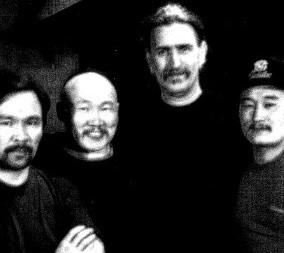 The first example is the opening of this piece, with four bars in the main 12/16 meter, getting interrupted by bars in 9/16 and 10/16. These two
bars can also be seen as augmentations of the 12/16 meter, because the bass pedal from the previous bar keeps being maintained. The scale is F Mixolydian
and the keyboard patterns are easy going: I-II-I in bars 1-5, followed by V returning to simply the tonic alone in bar 6. These chords get to a degree mixed
because of passing notes, so one might also interpret these chords somewhat differently. For instance one might also choose for II 7th in bar 1 instead of II,
when one sees the F as part of the chord. The F as a bass pedal is strongly present during much of this piece. Staff one represents a melody, that I thought
was coming from an unidentified synclavier instrument, sounding a bit like a flute when it goes up high.
In May 2020 Stefano Amitrano informed me of a performance of Kongar-ol Ondar at the David Letterman show, producing these sounds from his throat
(https://youtu.be/TVyyhHFKI8E).
This "flute" plays in a semi-improvised manner during most of the piece. Combined with the awkward
sound of the other throat-singing by the Tuvans, this gives the piece its special atmosphere.
The first example is the opening of this piece, with four bars in the main 12/16 meter, getting interrupted by bars in 9/16 and 10/16. These two
bars can also be seen as augmentations of the 12/16 meter, because the bass pedal from the previous bar keeps being maintained. The scale is F Mixolydian
and the keyboard patterns are easy going: I-II-I in bars 1-5, followed by V returning to simply the tonic alone in bar 6. These chords get to a degree mixed
because of passing notes, so one might also interpret these chords somewhat differently. For instance one might also choose for II 7th in bar 1 instead of II,
when one sees the F as part of the chord. The F as a bass pedal is strongly present during much of this piece. Staff one represents a melody, that I thought
was coming from an unidentified synclavier instrument, sounding a bit like a flute when it goes up high.
In May 2020 Stefano Amitrano informed me of a performance of Kongar-ol Ondar at the David Letterman show, producing these sounds from his throat
(https://youtu.be/TVyyhHFKI8E).
This "flute" plays in a semi-improvised manner during most of the piece. Combined with the awkward
sound of the other throat-singing by the Tuvans, this gives the piece its special atmosphere.
During the second example a new different pattern turns up in 9/16 (bar 3). Here the movement is VII-VI-V, played as parallel fourths and grouped as three times 3/16.
Bar 4 is a variation upon the previous bar with VII-VI repeated twice and ending with a grouping into two instead of three. At this point the bass starts moving for the first time,
here playing along with the lead melody on keyboard. Next the music turns over to the central 12/16 bar again with an F pedal.
The thirds example contains most of the little solo by Zappa in this song, thus being the lastly recorded example of Zappa playing guitar on a CD. The
patterns from the second example return, though not in an identical manner. Here the bass starts moving more freely with little melodies of its own.
After the solo the music switches to F major by changing the E flat to E natural. This using of two closely related scales next to each other is a common feature
in Zappa's music. In the fourth example the rhythmic pattern of the 12/16 bar returns once more, again interrupted or augmented with a bar in a different meters, 6/16 this time.
The harmony now follows I-II-I 7th in F. Towards the end Zappa modulates back to F Mixolydian.

The definition of throat singing according Wikipedia. In the transcriptions of "Dance me this", "Goat polo" and "Calculus" I've only notated the
root note of the sung notes, thus without the overtones.
Above to the right: Zappa with the Tuvans, 1992. Outtake from a photo by Ralph Leighton (CD booklet).

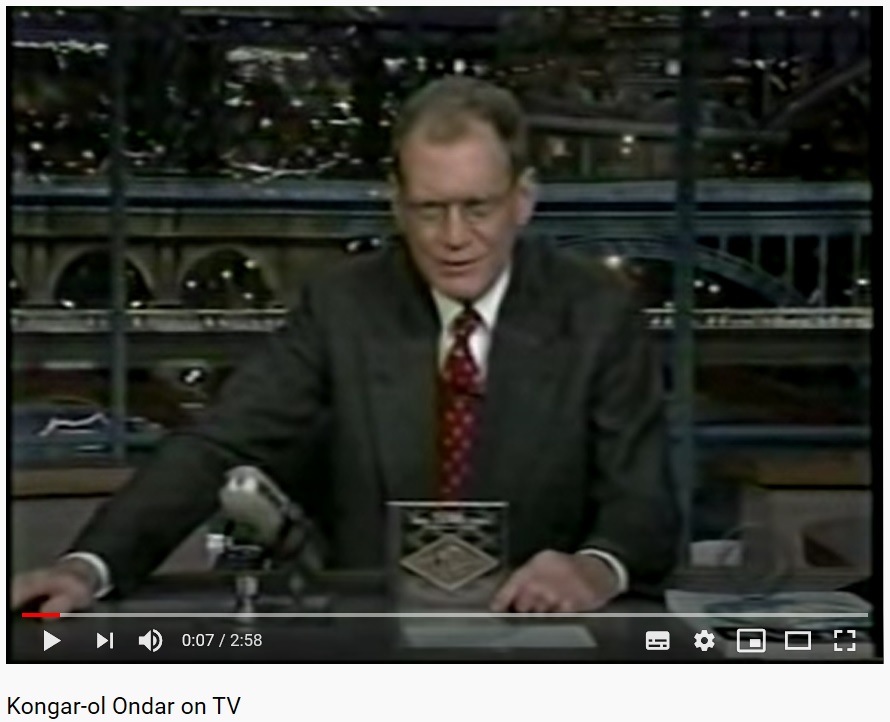
Kongar-ol Ondar at the David Letterman show, 02-11-1999 (Youtube copy mentioned above), with the following enrolling with Paul Shaffer:
- David: "A throat singing is a centuries old art form in which a, the singer vocalizes, right Paul, two to four notes at a time."
- Paul: "Wauw."
- David: "Right. A normal singer can how many ..."
- Paul: "One".
2. Pachuco gavotte
The second piece on this CD, "Pachuco gavotte", is another example of the grey
area between tonal and atonal. All notes from bar 1 from the example below are part of a diatonic scale,
but there's no real pedal note. Not in this bar, nor elsewhere in this piece. In bars 2-3 the bass plays notes that are chromatic
compared to the set of notes by the other parts, which keeps happening. Beats 3-4 of bar 3 suggest a modulation.
Pachuco gavotte, section (midi file).
Pachuco gavotte, section (transcription).
"Pachuco gavotte" is played via a number of layers. As represented in the example above:
- Staff 1: various embellishments.
- Drum beats line: the drums and percussion are using a wide variety of sounds. In a number of pieces on "Dance me this" the drum/percussion part is rather dense, becoming
a significant element in the whole, that's responsible for the sound of the composition. One might consider transcribing it in total. Here I limited myself to the beats only of
bars 1-2. They appear in two and in three ticks per beat, so the meter can be notated as either 8/16 or 12/16. All other parts play mostly in three, so the overall notation
looks easier in 12/16.
- Staffs 2-3. Notes jumping up and down over the pattern established by the bass and chords.
- Staff 4. The rhythm of the chords, next to the downbeat, is the only constant factor throughout this piece: 16th notes upon the third 16th tick of a beat. These chords sometimes
keep repeating, at other points they get adrift. In the example here, both are happening. These chords can be either enlarged ones (sus2 add 4) or regular
triads, belonging to varying scales.
- Staffs 5-6. The bass line. The length and position of the notes is deliberately kept irregular. The combination of the bass and the chords make it impossible
to call this piece normally diatonic, let alone tonal. It keeps moving and sometimes follows a scale implied by the chords, at other points it's chromatic.
3-7. Wolf Harbor
In Zappa's output collages can turn up in two different shapes:
- A construction made up of shorter pieces of music, snippets and fragments. "Lumpy gravy" is the best example, being in total a collage album.
Sequences of musical fragments can turn up elsewhere as well, like in "Greggery Peccary".
- Larger pieces of music that are made up of collections of sounds, not based upon playing notes by standard instruments. Zappa used the synclavier
to the full for creating
such sound collages. "Dio fa" and "Beat the reaper" are his larger efforts from "Civilization phaze III".
"Civilization phaze III" at first carried the title "Lumpy gravy phase III". The connection is made by the return of the piano people, the people
talking with their heads inside a grand piano. Musically "Lumpy gravy" and "Civilization phaze III" are hardly related. The first album is mostly
based upon written music, while "Civilization phaze III" is a mix of written music and collages in the second meaning. But also the written
music is pretty different, as you can check by the note examples included in this study.
"Wolf Harbor" is Zappa's largest piece, constructed as a sound collage. Its five movements last 28 minutes in total, all seguing. It's a fascinating world of industrial and harbor sounds,
at several points interrupted by percussion sections. These stem from "The rhythmic sadist's guide to drum patterns for the 21st century",
as explained in the liner notes. So actually the CD tracks are a combination of two compositions, that alternate each other. It works efficiently:
28 minutes is long for a collage piece, but by its variation Zappa manages to keep your attention very well all through. As I've been explaining
in the previous section, sound collages like this one are very difficult to approach in regular sheet music notation nor would it make you much wiser.
It needs a vocabulary and a reference environment of its own. Because of the size and quality of this piece, I felt compelled
to do something with it nevertheless.
Wolf Harbor (I), 1:22-1:31 (approximation).
This example here above is an attempt to capture a fragment from the first movement in standard note notation. During part of
the first movement you can hear a figure of two gong
ticks, recurring at equal intervals. It's sort of a mantra happening between 1:22-2:55, 4:32-5:31 and 6:52-7:03.
This mantra occasionally returns in the other movements too: shorter periods in Mvt. III, beginning at 1:12 and 2:25,
and in Mvt. V, beginning at 2:22 and 2:37. It makes it possible to draw
the meter lines during these sections in a sensible way. The figure itself can be reasonably approximated within a 10/8 meter. This doesn't
mean that it's for certain that Zappa composed these sections in 10/8. It only means that, if you want to put it on paper,
10/8 seems to be viable. The mantra is notated in staff 8. Staves 3-4 contain a sustained "shiphorn" Eb, fluctuating a little.
Next you've got other sustained and gliding notes, as well as several shorter notes, sometimes musical, sometimes undefined
scratching sounds. The fluctuations and dynamics matter more than average in compositions like this. My midi editor doesn't support
enough functions to include a midi file of this example too.
The percussion sections alternate with the collages in the following manner:
- A: Industrial and harbor sounds collages.
- B: Percussion sections.
Wolf harbor
0:00 A
6:35 A+B
7:05 B
Wolf Harbor (I), 7:16-7:18 (approximation).
Above a tiny fragment of 2-3 seconds from the percussion part. Zappa almost systematically avoids steady downbeats during the percussion sections, for which
reason I'm not trying to notate a meter in this little sample. A wide range of percussion instruments is being used, many
having pitches, with several sounding as bongo-like drum beats. Even the scratch-like sounds tend to have pitches. It also involves regular snare drum and bass
drum beats, as well as a range of cymbals, thus combining normal drum parts with a large amount of synclavier percussion ranges. The synclavier facilitated this:
when entering a percussion sample with a certain pitch, it could be transposed to any pitch.
7:25 A+B
7:44 A
8:02 End
Wolf harbor II
0:00 A
0:02 B
0:23 A
1:46 B
5:48 A
6:25 A+B
6:52 End
Wolf harbor III
0:00 A
Wolf Harbor III, 3:43-3:51 (sketch).
While during mvt. II the percussion sections got the upper hand, the industrial and harbor sounds are dominating in mvt. III. Many sounding variants of
dripping, gurgling, floating and flushing water are passing by. Between 3:27-3:58 a steadily repeated squeaking F can be heard, that I've
used to draw dashed meter lines in the last sample above. I can't get this above a sketch level, with only approximations of the note durations.
So a regular meter can't be specified. Over this repeating squeak a couple of sustained notes can be heard in all registers (very low to very high),
combined with a few
very brief melodic movements. The squeak can be heard in different positions of the stereo field, indicated as R (right) and M (middle) in the example.
The other notes/sounds are double-channeled. When I'm hearing it correctly some notes are quatertones.
5:57 B
6:09 End
Wolf harbor IV
0:00 Predominantly B
1:04 A
2:22 B
3:38 End
Wolf harbor V
0:00 B
0:40 A
Wolf Harbor V, 2:01-2:08 (sketch).
This last fragment from Mvt. V is taken from the section where a gamelan and a metal-clangs melody can be heard
playing in sort of a two-part counterpoint-like manner. It lasts a bit longer than in this example, up to 2:13,
when a shiphorn re-enters the picture. Again it's only a sketch with approximations of the note durations. The dashed
lines are merely there to improve the readability, there are no hard clues for where to put meter lines.
"Wolf Harbor" doesn't know anything that resembles a classical structure, like themes or returning motifs. It does
know returning sound groupings and the mentioned mantra. The subdivision into five movements appears to stem from how Zappa constructed
this collage, probably known to himself only. When listening to it, you can't here switches or pauses, it all segues.
Obviously "Wolf Harbor" is atonal when "musical" melodies are turning up, not only because of the
lack of clear tonics, but more explicitly because of notes altering.
3:08 End
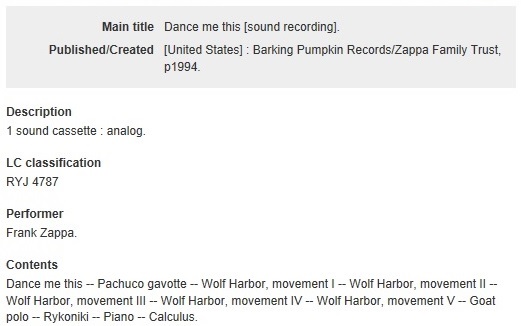
In 1994 the ZFT deposited a cassette copy of "Dance me this" at
the Library of Congress, the U.S. national library. For long the
only public copy, but now luckily normally available on CD for everybody. Because of this copy, the titles of the
tracks from "Dance me this" were known to Zappa fans for years.
Zappa's sample collection, the collection of sounds stored into the synclavier, upon which "Wolf Harbor" is heavily drawing, is coming by in the huge
Zappa interview by Don Menn, published in Zappa! (Special issue by the publishers of Keyboard and Guitar Player). At "N-lite" in the previous section I'm citing
page 42, which I'm doing some more and more extensively here. He's being asked: "How do you catalog your samples? Is it broken down by car-bumpers-falling-off noises versus ...". Zappa begins answering as: "That would be under
"Industrial". It's completely broken down. Not only that, I think we've got tens of thousands of samples by now, and you memorize their names. There's an eight-digit computer name for each of these
things. I can sit there and watch the thing, and I can see the name of the sample, and I know what it sounds like. I know every one of these little bastards. I know how far it will
travel on the keyboard all by itself. I know this stuff inside and out. To be able to write music for that kind of sound universe offers some major opportunities if you have
time to do all the typing to manipulate it properly. And there's never enough time at one sitting to finish something, because the more you get into it, the more you understand it could sound a lot better
if it only had this nuance or that nuance. And every nuance you want to add takes hours, which then go into days which go into weeks, and on and on.
And every of those nuances needs to be defined - amplitude for each note, whether the note has vibrato or whether it's going to bend to the next note, all that stuff.
All that has to be typed in as data. And it has to be transferred to tape, then it has to be mixed."
8. Goat polo
Not much is known about the visit of the Tuvans in Zappa's studio other than what Ralph Leighton writes in the liner notes.
They were only there for one night and a few recordings could be done. The postponement of
the CD release didn't help, not for its promotion and not for things as interviewing the Tuvans. In my opinion "Dance me this" is a masterpiece. "Goat polo" sounds
as if Zappa and the Tuvans were a well-rehearsed band, but this is an illusion. With his synclavier he could add any written music to a basic track, sung
by the Tuvans. In case of "Calculus" - see below - it's known in detail how this illusion was created.
Goat polo, 2:28-2:36 (midi file).
Goat polo, 2:28-2:36 (transcription).
Half of "Goat polo" is built around a number of sustained notes by the Tuvans. In the example from above it's a sustained D as root of the sung chord (staff 4).
On his synclavier Zappa is playing A-D as pedal chord by a drone bass and piano. See also the previous section at "Put a motor in yourself"
for his fondness of fourths. On top of this a melody gets played, following/completing the A major scale.
This melody is rhythmically highly irregular. This is characteristic of many later synclavier works, making transcribing it difficult, let alone getting
to a performable score. The example from above can only be a reasonable approximation. If you play it like this, it gets fairly even.
In his autobiography "Life", Keith Richards talks about musical notation in chapter III, saying: "I forgot to mention that to play the blues
was like a jailbreak out of those meticulous bars with the notes crammed in like prisoners, like sad faces." He calls the possibility to play
music off record a form of emancipation. As is comes to blues he's absolutely right. When you can buy recorded blues music and when you have
the ability to play it from record, then you don't need sheet music as an intermediary station anymore. Apart from that blues is not only about the notes played but also
about how they are played, audible on record, but not visable in the shape of sheet music. Like Richards, Zappa had a large collection of blues records and
probably played from record as well. He was proud of being able to create the "distorted" sound as in "Metal man has won his wings"
(see the Working with Paul Buff section), the sound he tried to imitate from some of his fifties records. This particular sound is something I can't reproduce in a transcription, nor does the collection of midi sounds
support it.
In other circumstances sheet music can come in handy or even be crucial. For Zappa the synclavier meant that he didn't need a band anymore to actually
hear his music and that he could compose whatever he wanted without having to bother if he himself or somebody else could play it. The synclavier
could play any sheet music with a digital perfection. On a lesser level, this also goes for the transcriptions and midi files in this study. For me the
emancipation works the other way round. I can hardly play instruments, but because of the possibility to write things down in musical notation, I'm still able
to actively do something with it. Apart from playing guitar himself, Zappa enjoyed writing for orchestras from the beginning of his career as well as letting other
people play music he couldn't perform himself. Then sheet music becomes a necessity. Some tracks on "Dance me this" show the convenience
of musical notation. Without a band and with only some basic tracks by the Tuvans, it's still possible to create full-blown compositions.
9. Rykoniki
The next example is the end of "Rykoniki".
In general one would take staff five from my transcription below as the lead melody and interpret staffs 1-4 as complementary harmony.
Within the context of Zappa's music things can also be interpreted the other way round. Because of its repetitions, staff five can also be seen as a vamp, while
staffs 1-4 form the lead melody. In that case the vamp would be exceptionally long and the lead melody a slow hocketing movement.
This vamp gets repeated around six times. It's impossible to be sure how the meters are running straight from CD. In the example they
are nothing more than my notational choice. It's also unclear what the starting point of the vamp is. The track begins with bar 2 from my example
(after a drumroll) and ends with bar 6. The example contains one whole period with all the notes from the vamp. Either "Rykoniki" begins halfway the vamp
or ends halfway the vamp. The reason why staff five can be seen as a vamp is that Zappa composed more often in this manner. See for instance the "One man - one
vote" and "Massagia Galore" examples in this study.
Rykoniki, end (midi file).
Rykoniki, end (transcription).
"Rykoniki" is a short piece, atonal and deliberately irregular. Only in the directions of the notes and the chromatic grouping of them some patterns can be discerned.
Regarding staff 5 bar 1 is for instance using all notes from B to F and bar 5 the notes from C to F. Rhythmically eighth notes alternate with 16th notes, mostly as strings of one
of these two values. In the liner notes Todd Yvega explains that he and Zappa experimented with "burglar music", the phasing of a couple of melodies, each played
in a loop. When they are played together as one piece (with the same time units for all parts) and when they have different lengths, the combinations of notes keep varying till ultimately they all
get to a point where they continue exactly as they started. It can be calculated. With two very short melodies of three and four ticks
you already get at this point at tick 13. But if you would do it with a few vamps as the one from above, playing them simultaneously, it could take hours to reach this point.
See also my comment upon "Lucy's seduction of a bored violinist & postlude" in the 200 Motels section of this study.
10. Piano
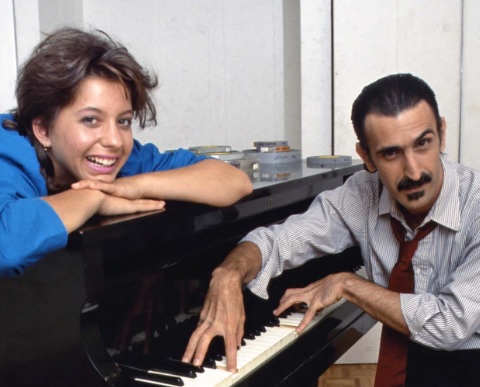 As an excellent guitar player, but only an average keyboard player, Zappa rarely wrote for solo piano. The occasions that he did, however, are surprisingly
strong. In this study a few bars from the piano introduction to "The little house I used to live in" are included, as well as some examples from
"Ruth is sleeping". The first composition can be found in total in the Frank Zappa Songbook vol. I. With "Piano" from "Dance me this" Zappa is not only adding
an impressive new title to his own catalogue, but to piano repertoire in general. Again he's coming up with new perspectives. During the first half
cells stand central with strings of notes using smaller intervals, circling around quickly and irregularly within smaller ranges.
To the left Frank and Moon at his non-digital piano (outtake of a photo by Elisa Leonelli).
As an excellent guitar player, but only an average keyboard player, Zappa rarely wrote for solo piano. The occasions that he did, however, are surprisingly
strong. In this study a few bars from the piano introduction to "The little house I used to live in" are included, as well as some examples from
"Ruth is sleeping". The first composition can be found in total in the Frank Zappa Songbook vol. I. With "Piano" from "Dance me this" Zappa is not only adding
an impressive new title to his own catalogue, but to piano repertoire in general. Again he's coming up with new perspectives. During the first half
cells stand central with strings of notes using smaller intervals, circling around quickly and irregularly within smaller ranges.
To the left Frank and Moon at his non-digital piano (outtake of a photo by Elisa Leonelli).
Piano, 0:30-0:41 (midi file, tempo changes not included).
Piano, 0:30-0:41 (transcription).
It looks like the example from above is based upon note entry, as probably the whole piece is. Bars 1-3 have the 16th note as the basic time unit,
bars 4-8 the eighth note (as it comes to the distances between notes coming up), bar 9 the quarter note and bar 10 the eighth note again. Rhythmic
variation is achieved by using different meters, tempo
changes, accelerandos and ritardandos. Only bar 1 is diatonic, being in A Dorian. All other bars
are chromatic/atonal. The figure in the upper staff, bars 2-3 and 9-10, is an example of a string using smaller intervals. You can discern
a repeating E-Eb(D#)-C-Db(C#) motif. The different staves are used to position notes spreading out over the stereo field, while their sound can also
vary a little. Various harmonies are formed
by sustaining notes. Their durations in the two transcriptions below are by approximation. Zappa is also permanently using a light pedal effect for his digital piano, so
I can't get that aspect exactly notated. You can also see that counterpoint lines are formed during bars 2-3. When you take the positions
in the stereo field as a distinction, you might call bars 4-7 an example of hocketing.
Piano, 5:58-6:09 (midi file).
Piano, 5:58-6:09 (transcription).
The second half sounds
like one big never ending deceptive cadance. Here it's not the piano playing solo just alone, but soloing along "orchestral" chords. Whenever it appears as
if the music might come to a resting point at a certain chord, it immediately starts searching again for another direction. So it keeps surprising you till
eventually of course, it really has to end. The second example contains 10 seconds from this block. Rhythmic variation is achieved by constantly
changing the meters, mostly odd meters, and using different note values. Harmonically the following is happening:
- Bar 1: The basis during the example are sustained open fifth chords. Bar 1 begins in G Mixolydian, but halfway the melody turns
over to using notes from the next key from bar 2.
- Bar 2: F# Dorian. With the last two 16th notes the melody moves over to the key of the next bar.
- Bar 3: F minor. Soon altered notes are turning up.
- Bar 4: D pedal, with the melody immediately starting off chromatically.
- Bar 5: D pedal some more. As you can see, the pattern with notes going up and down again keeps returning. Some bass notes with
toms and bass drum serve as pick-up notes for the next bar. The accent in bars 5 and 6 has shifted from 16th notes to eighth notes and dotted eighth notes.
- Bar 6: The downwards movement continues. I've notated this as a separate bar to ease the readability.
- Bar 7: G major and Lydian. First the C turns up as natural, switching to C# for the remainder of the bar.
As you can see and hear, nowhere does the music come to a resting point. It just keeps modulating, switching pedal notes, and getting chromatic at several points.
11. Calculus
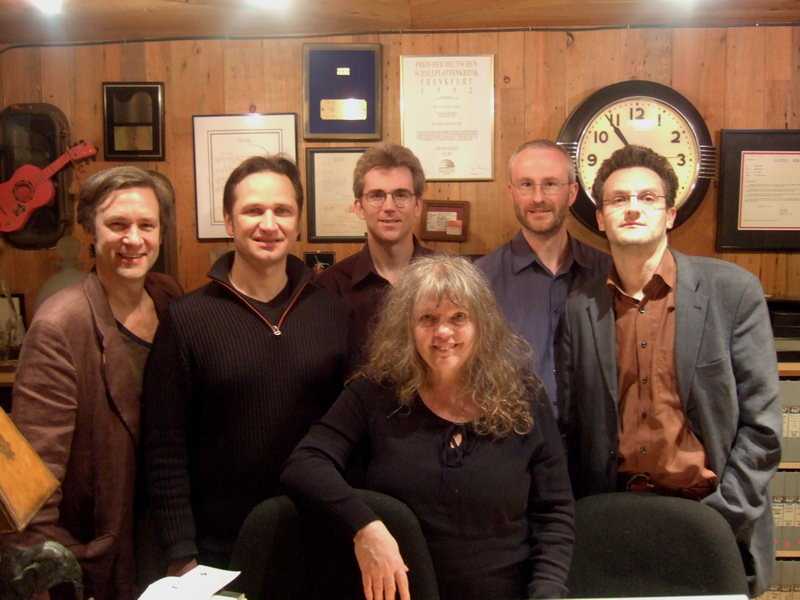 "Dance me this" ends with a collaboration. It has an a capella track sung by Anatolii
Kuular as starting point. It's largely the G (root) note getting repeated and pulsing with different
vocals and tempo changes. Zappa suggested to convert these tempo changes into a table
that could be used to apply to any synclavier piece. Todd Yvega calculated the necessary
time changes to get everything equal. To try it out he typed in or re-used an improvised-like bass
line in standard 4/4, accompanied by violin pizzicato notes, generated by an algorhythm. There are also harmony notes
used in this piece, so probably it got further edited. Since none of the previous
tracks on "Dance me this" use standard danceable 4/4, Zappa liked to close the album like this. As is gets said in the CD liner notes
"some relief by way of a mindless foom-fop is exactly what we need". Still the combination of parts and more specifically
the tempo changes make it exciting. To the left Todd Yvega (center) with members from the Ensemble Ascolta, visiting Gail Zappa
in 2007 (photo downloaded from the United Mutations site)
"Dance me this" ends with a collaboration. It has an a capella track sung by Anatolii
Kuular as starting point. It's largely the G (root) note getting repeated and pulsing with different
vocals and tempo changes. Zappa suggested to convert these tempo changes into a table
that could be used to apply to any synclavier piece. Todd Yvega calculated the necessary
time changes to get everything equal. To try it out he typed in or re-used an improvised-like bass
line in standard 4/4, accompanied by violin pizzicato notes, generated by an algorhythm. There are also harmony notes
used in this piece, so probably it got further edited. Since none of the previous
tracks on "Dance me this" use standard danceable 4/4, Zappa liked to close the album like this. As is gets said in the CD liner notes
"some relief by way of a mindless foom-fop is exactly what we need". Still the combination of parts and more specifically
the tempo changes make it exciting. To the left Todd Yvega (center) with members from the Ensemble Ascolta, visiting Gail Zappa
in 2007 (photo downloaded from the United Mutations site)
Calculus, opening (midi file).
Calculus, opening (transcription).
The above example is the opening. It has the pizzicato notes in staff one, Anatolii singing in staff 2, harmony notes in staff 3 and the bass line
in staff 4. The sung G can be taken as the tonal center. The music is diatonic, though not following a standard scale. The mostly used string is
G-A-B-C#-D-E-F, though the harmony is using a C natural. Every once in a while the eighth notes of the bass line get interrupted by bars with
a pedal note, creating short pauses within the pattern. Bars 6-7 show an F and an Eb pedal, the latter suggesting a modulation, but not really coming off.
The pizzicato notes keep using an E natural and in bar 9 the music returns to its starting pattern.
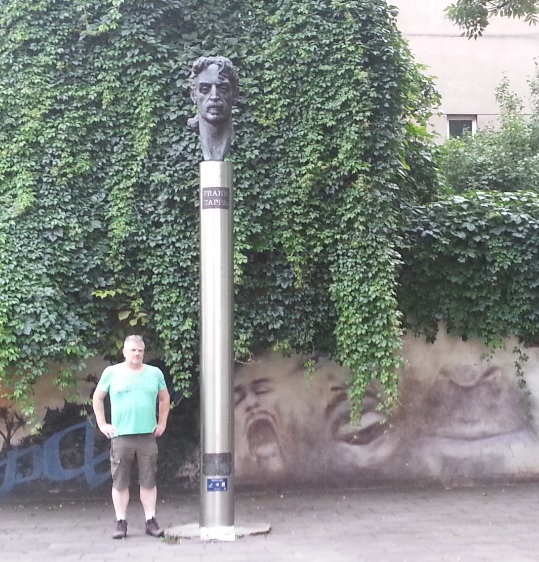
The Zappa statue at Vilnius (photo by a collegue of mine).
FRANK ZAPPA FOR PRESIDENT
Overture to Uncle Sam
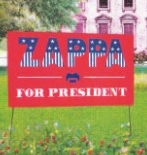 As it comes to releasing new material, "Frank Zappa for president" is a major contribution to Zappa's output.
The opening piece, "Overture to Uncle Sam" is a 15-minutes synclavier piece. In the "Dance me this" liner notes, this work gets
mentioned as a piece Zappa was working on in his last year. Other than "Feeding the monkeys at ma maison", that has the character
of work in progress, the "Overture to Uncle Sam" sounds as a finished composition. It's a carefully constructed piece with a couple of themes/motifs,
that continuously get varied upon. The sounds belong to the set of sampled sounds from real acoustic instruments. The music gets led over
various groups of what you could call a chamber orchestra. It's based upon note entry and has been partly performed as such by the
Ensemble Ascolta in 2007. Andrew Digby wrote me that they have the first 6 minutes on paper, while still working
on the complete piece (status November 2016). Their site contains a sound example (see the previous section at "Reagan at Bitburg").
Two more synclavier pieces are included on this CD. "Medieval ensemble" is an earlier work. It's atonal and a rather wild example
of Zappa applying counterpoint. An example taken from it, is included in the Jazz from hell section.
Both pieces are pretty interesting technically as well, because, yet again, news facets are added
to Zappa's repertoire. Of importance is also the vocal version of "Amnerika", of which the opening is included in the Thing-Fish section.
To the right an outtake from the CD booklet with an imaginary "Zappa for president" sign in front of a government building.
As it comes to releasing new material, "Frank Zappa for president" is a major contribution to Zappa's output.
The opening piece, "Overture to Uncle Sam" is a 15-minutes synclavier piece. In the "Dance me this" liner notes, this work gets
mentioned as a piece Zappa was working on in his last year. Other than "Feeding the monkeys at ma maison", that has the character
of work in progress, the "Overture to Uncle Sam" sounds as a finished composition. It's a carefully constructed piece with a couple of themes/motifs,
that continuously get varied upon. The sounds belong to the set of sampled sounds from real acoustic instruments. The music gets led over
various groups of what you could call a chamber orchestra. It's based upon note entry and has been partly performed as such by the
Ensemble Ascolta in 2007. Andrew Digby wrote me that they have the first 6 minutes on paper, while still working
on the complete piece (status November 2016). Their site contains a sound example (see the previous section at "Reagan at Bitburg").
Two more synclavier pieces are included on this CD. "Medieval ensemble" is an earlier work. It's atonal and a rather wild example
of Zappa applying counterpoint. An example taken from it, is included in the Jazz from hell section.
Both pieces are pretty interesting technically as well, because, yet again, news facets are added
to Zappa's repertoire. Of importance is also the vocal version of "Amnerika", of which the opening is included in the Thing-Fish section.
To the right an outtake from the CD booklet with an imaginary "Zappa for president" sign in front of a government building.
Overture to Uncle Sam, 10:41 till 10:52 (midi file).
Overture to Uncle Sam, 11:09 till 11:16 (midi file).
Overture to Uncle Sam, sections (transcription/approximation).
Above are two fragments from the "Overture to Uncle Sam". Both are largely duets. The first between a "bassoon" and an oboe. I have to put the indication
bassoon between quotes, because it's getting higher than the range of a real bassoon allows. This is played at the beginning
of the part, where counterpart movements are getting the upper hand. This little example is atonal. It's free counterpoint with
two melodies interacting. It's starts in 2/4, after which the meters
are getting to vary. The second fragment is a duet between two violins. Again this example is an approximation only as it comes to the
rhythm. The sound involves another combination from the chamber orchestra, strings versus the woodwinds from above. Stylistically
it's also quite different. This snippet contains diatonic material, though not having a specific tonic or following one particular scale.
The set-up is homophonic with the second staff offering harmony notes below the lead melody from staff 1. In bar 5 stereo effects are
used to let the notes of the music come from different parts of the stereo field. It's indicated as M-R-L in the example, middle-right-left.
